North America is home to hundreds of species of caterpillars. Some of them are butterfly caterpillars with distinct colors and host species.
These caterpillars grow on trees, flowers, and legumes.
The following caterpillars have a common nature and may be easy to find in their natural habitat.
Table of Contents
1. Monarch caterpillar
Monarch caterpillars (Danaus plexippus) go through 5 instars before emerging as adult common butterflies.

This caterpillar is green or gray in its first instar. The rest of its instars show distinct black, white, and yellow bands across the body which grow in size as the caterpillar grows.
Caterpillars of this genus are commonly found on milkweed and they may become aggressive toward each other based on low food availability.
These caterpillars finally move away from milkweed in the fifth instar when they stop feeding. They seek out a shelter pupating place.
2. Eastern Tiger Swallowtail caterpillar

Some caterpillars drastically change colors before pupating and becoming adult butterflies.
This is also the case with the color-changing Eastern Tiger Swallowtail (Papilio glaucus). These caterpillars have a brown color in the first instars which changes to green coloring in late instars.
Eastern Tiger Swallowtail caterpillars are further distinguished by large eyespots on the dorsal side.
These caterpillars are seen on a wide range of hosts, including trees. Tulip trees are a common host of the species.
3. Gulf Fritillary caterpillar

You can find Gulf Fritillary caterpillars (Dione vanillae) on different types of passiflora genus flowers.
These flowers host one egg each. A yellow egg is laid which then turns into a growing caterpillar.
Gulf Fritillary caterpillars eat the leaves of their host plants before emerging as butterflies.
Inner leave sections are preferred in the first instars with a preference for outer leaves in late instars.
The caterpillar has orange-brown nuances with black secondary coloring, a combination also specific to the emerged Gulf Fritillary butterfly.
4. Black Swallowtail caterpillar
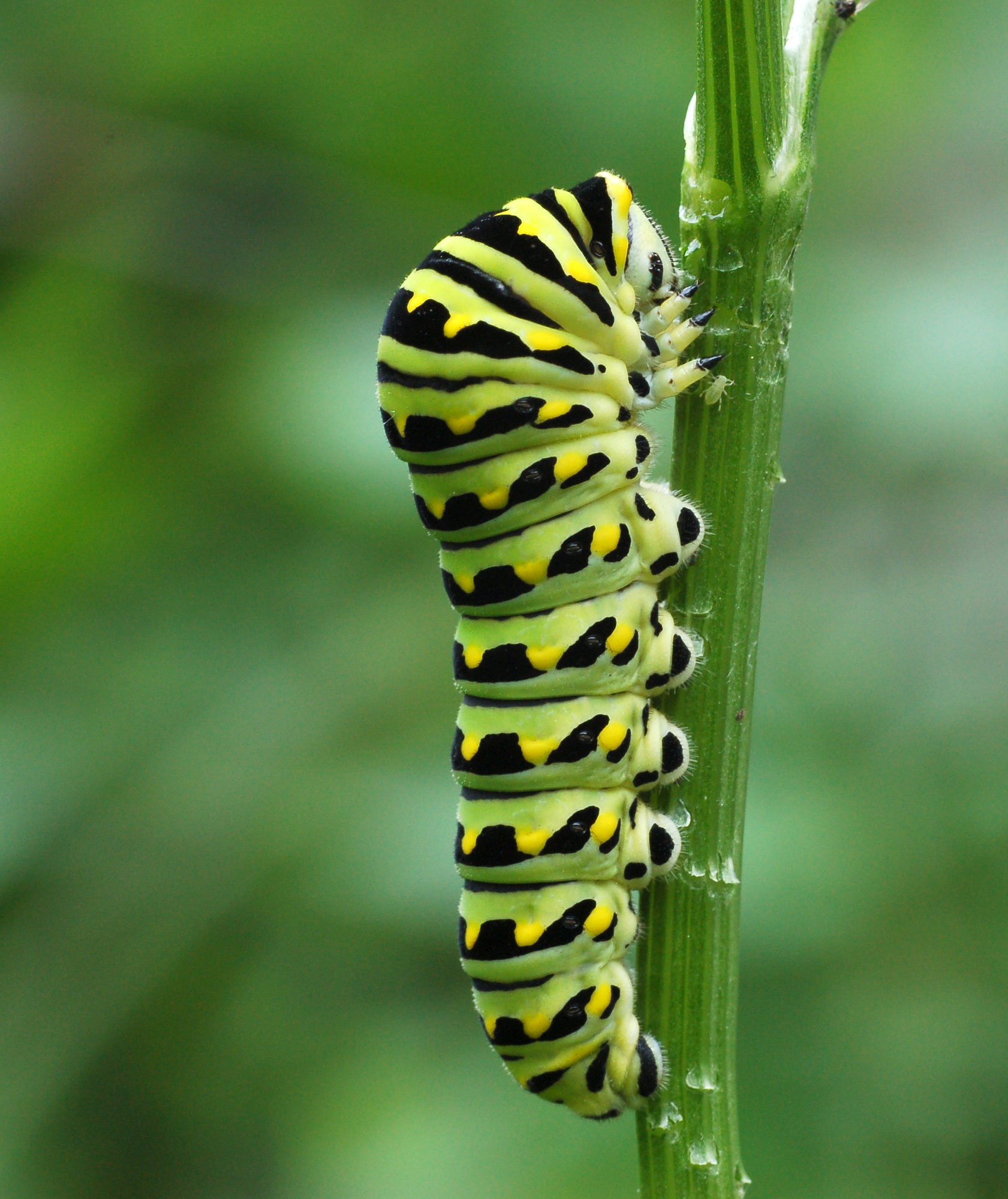
The green coloring is specific to the Black Swallowtail caterpillar (Papilio polyxenes) which then turns into a mostly black butterfly.
Some caterpillars of the species might be brown, while others also differ in their green nuances.
The habitat might be one of the elements that influence the green color of the caterpillar with its black dorsal stripes.
This caterpillar is also known for absorbing plant toxins. This makes it have a bad taste to predators.
Caterpillars of this genus can also release foul-smelling chemicals from a defensive organ gland.
5. Small White caterpillar

Small White caterpillars (Pieris rapae) grow into almost completely white butterflies. They are dependent on nitrogen-rich foods.
Cabbages are among the most common hosts of this caterpillar.
Living secretive lives, the caterpillars bore to the center of cabbages where the new soft leaves are found.
Both cultivated and wild cabbages are good hosts for Small White caterpillars.
Other less common hosts include garlic mustard.
The rich green color is specific to these caterpillars.
6. Pearl Crescent caterpillar

Pearl Crescent caterpillars (Phyciodes tharos) grow into orange and black butterflies.
An expanded habitat is specific to these caterpillars which grow on different hosts.
Dogbane, shepherd’s needle, and milkweed are some of the common plants the caterpillar feeds on.
Asters in sunny open areas also attract the species.
Dark brown with spikes in its later instars, Pearl Crescent caterpillars have small black patches on the head.
Multiple caterpillar broods are specific to this species across North America.
The species is active throughout the year in tropical climates.
7. Common Buckeye caterpillar
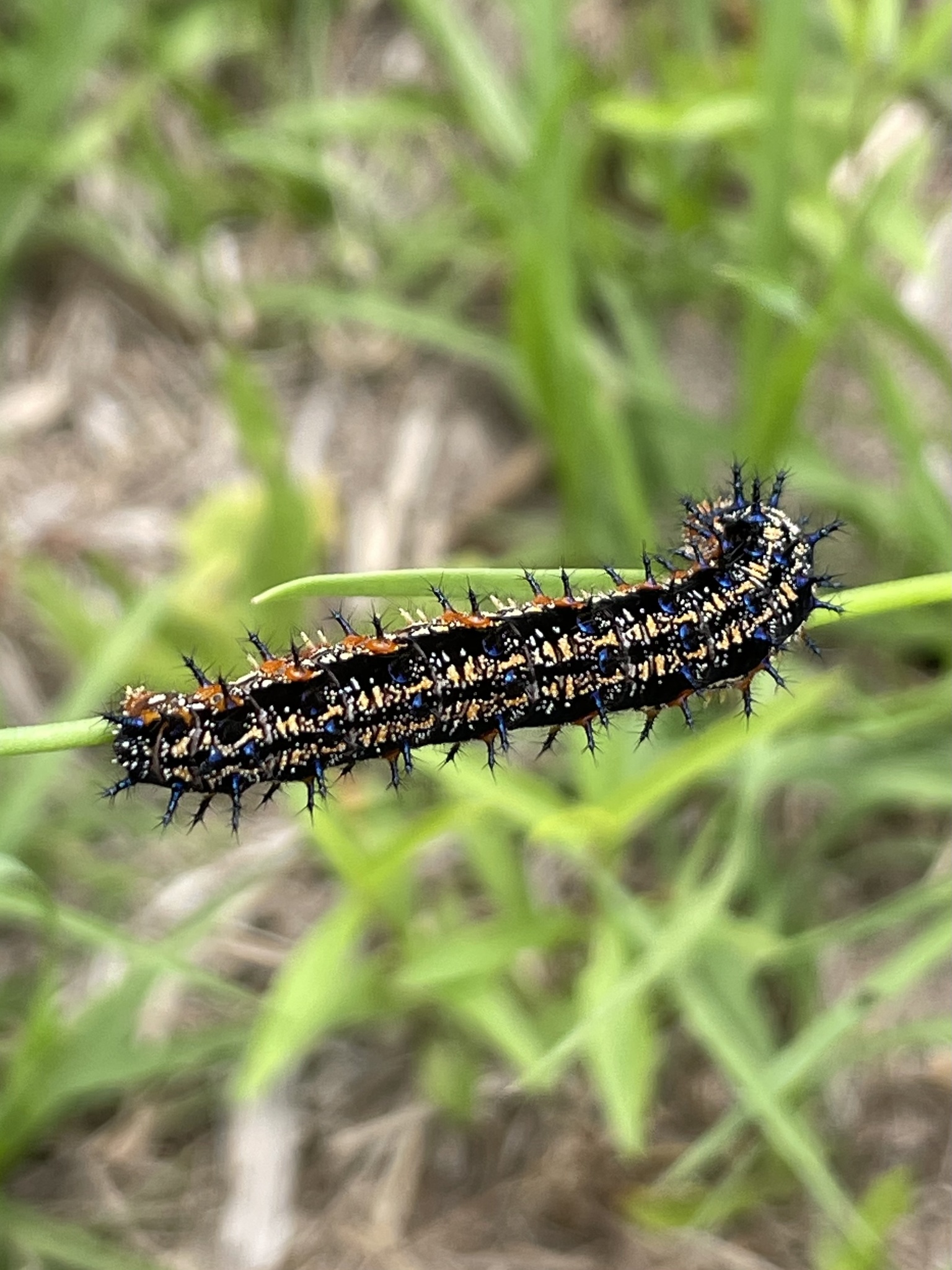
Brown, gray, beige, and black colors are specific to the species (Junonia coenia).
Black spines dominate the defensive appearance of the species with sporadic contrasting white spines.
Similar coloring and spikes are seen on caterpillars of other butterflies such as Red Admirals.
Some of the colors the caterpillar appears in are also seen on the Common Buckeye butterfly.
Dark brown and black are among the dominating colors of the adult butterfly.
Caterpillars of this species live on their own and are not grouped like other caterpillars.
8. Red Admiral caterpillar

Red Admirals (Vanessa atalanta) are some of the earliest described butterflies. With a wingspan of around 2 inches, these butterflies are easy to identify based on their black colors.
The caterpillars of the species are mostly black with white or yellow spots across the sides.
Caterpillars of this family are short, reaching a maximum length of around 1 inch.
Black spines are further visible across its body. The spines appear from the first instar.
Nettle is the main host of the Red Admiral caterpillar. Stinging nettle is where the caterpillar is mostly seen on.
9. Painted Lady caterpillar
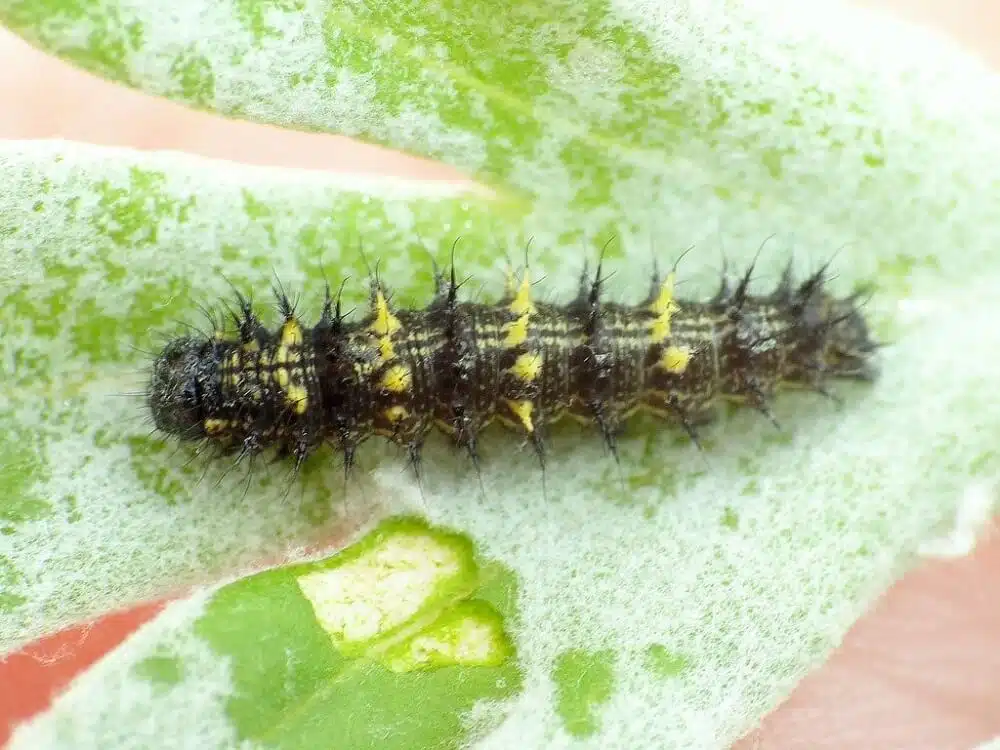
Asters are where Painted Lady caterpillars (Vanessa cardui) live on. They feed on various asters in open fields and are characterized by a gray color with white hairs and black stripes.
Small spherical green eggs are laid in large numbers before this caterpillar arrives.
The emerging adult has colorful wings with black, orange, and white patterns across the wings.
Painted Lady eggs are often laid on asters in warmer climates as the species is known for sometimes migrating long distances.
10. Red-spotted Admiral caterpillar

White, green, gray, and black colors are typical of the Red-Spotted Admiral caterpillar (Limenitis arthemis).
These caterpillars mimic viceroy caterpillars and they also have the appearance of bird droppings.
The irregular coloring that makes them similar to bird droppings makes these caterpillars look distasteful.
The species grows to 1.6 inches as a caterpillar and up to 3.5 inches as an adult.
Its appearance changes from an adult butterfly to a mostly black and blue species.
You can find this species of caterpillars in Eastern and Southeastern US territories.
11. Silver-spotted Skipper caterpillar
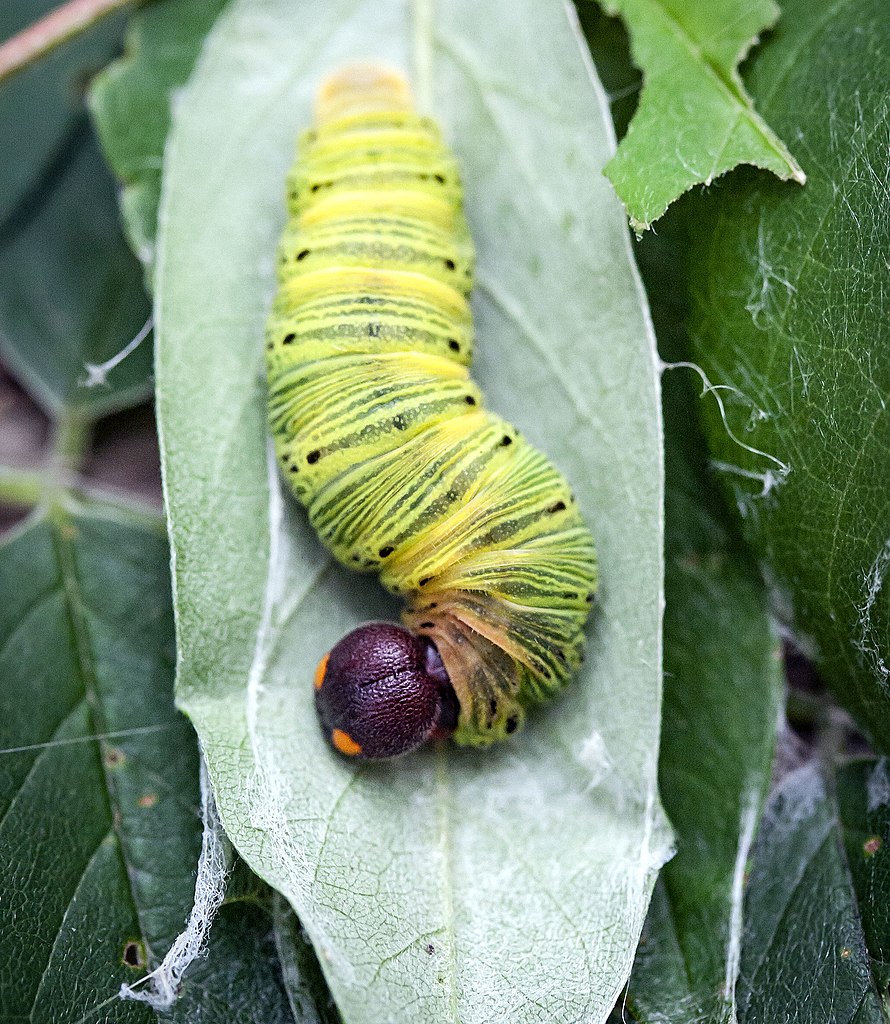
Silver-spotted Skippers (Epargyreus clarus) have a distinct yellow or yellow-lime color which makes them stand out.
These caterpillars grow up to a length of 2 inches and are represented by a yellow color with red or black dots across the body.
Brown is the main color of the head.
Silver-spotted Skippers start to turn brown into pupal stages and later into emerging butterflies.
Adults have a similar size to caterpillars. The Silver-spotted Skipper has a wingspan of up to 2.4 inches.
12. Pipevine Swallowtail caterpillar

This species of caterpillar (Battus philenor) is named after the pipevine plants they feed on.
It changes colors as it goes from one growth stage to another. Brown, bright red, and black colors are all specific to this caterpillar.
Its chrysalis has light brown and dark brown colors, resembling dead leaves.
Emerging adults bear some color resemblance to these caterpillars with black and iridescent blue wing colors.
Some species of pipevine such as California pipevine can be toxic to this caterpillar and may even kill them.
13. Gray Hairstreak caterpillar

Gray Hairstreak caterpillars (Strymon melinus) are initially green. No spikes are seen on the early instars of the caterpillar.
This species then turns brown, with just a few short brown hairs covering its body.
It can be seen on multiple host plants.
Pea family plants are among its most common hosts. It feeds on both the plant and the fruits of the plant until emerging as an adult.
You can also see this caterpillar on a few types of mallows.
The Gray Hairstreak caterpillar doesn’t carry on any others to its adult butterfly appearance.
14. Spicebush Swallowtail caterpillar

As the name implies, this species of caterpillar (Papilio troilus) is mainly seen on spicebush.
As it matures, the caterpillar brightens to a final yellow or lime-yellow color.
Dark yellow lateral coloring is specific to the caterpillar.
Small black dots are visible on the dorsal side of the species. White large eyespots and black large eyespots are visible on the back of its head.
These are defensive eyespots made to deter predators. By some theories, these large eyespots are characteristic of caterpillars that mimic snakes.
15. American Lady caterpillar

American Lady caterpillars (Vanessa virginiensis) are seen in different colors such as red, white, and yellow.
Some caterpillars are only seen in black and yellow colors. Yellow multiple narrow bands across the body are specific to this species.
Small white dots are seen on the dorsal side between its yellow bands.
The pupae of the species can be green, brown, black, and yellow.
Silk pads are seen around these caterpillars. They can protect caterpillars which need to keep wasps and other predators away.
16. Variegated Fritillary caterpillar

This species (Euptoieta claudia) begins life as a cream egg.
Emerging Variegated Fritillary caterpillars are mostly red, white, and black. Longitudinal stripes make this species stand out.
Black spikes are seen along its body.
The species then brightens to a white base color with orange and black spots forming the chrysalis.
Orange and black are the final colors of the Variegated Fritillary butterfly.
You can find this caterpillar on multiple host plants and flowers.
Violets are among the host flowers of the species.
Plantain is a common host plant for the species across North America, together with American Field Pansy.
17. Queen caterpillar

Queen caterpillars (Danaus gilippus) are among the few species that aren’t tasteful to predatory birds.
These absorb plant toxins and have a bitter taste to most predators such as small birds.
Black coloring is specific to these caterpillars.
White bands and yellow dots are further distinguishable on the body of the species.
Seen on butterfly weed and many other plants in Europe and North America, the species is still a common sight on milkweed.
Adult butterflies change their diet to fruit, dung, and dead leaves.
18. Hackberry Emperor caterpillar

Hackberry Emperor caterpillars (Asterocampa celtis) are identified by a base green color with light green or yellow dots and lateral stripes.
This species has the color of the leaves in eats.
Further physical traits include a brown head and brown contrasting horns.
The pupae of the species are also green but of a faded nuance, similar to rolled leaves.
Hackberry tree leaves are the most common host for this caterpillar before a black and brown butterfly emerges.
This species is native to Central and North America with reduced Florida populations.
19. Question Mark caterpillar
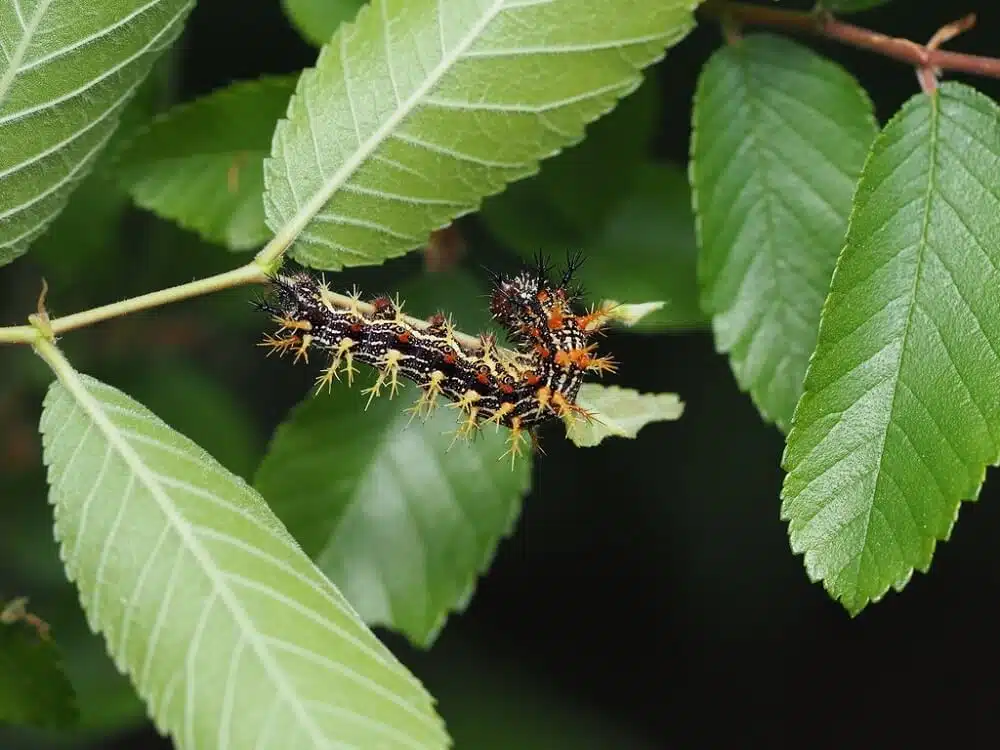
Yellow, orange, and black colors are the most common on Question Mark caterpillars (Polygonia interrogationis).
The species is known for its multiple-colored spines, which can also be orange.
Question Mark caterpillars grow to a maximum length of 1.6 inches, similar to Hackberry Emperor caterpillars.
Brown is the main color of Question Mark pupae, similar to dead tree leaves.
One or multiple Question Mark broods are seen each year.
The species may sometimes not survive tachinid fly parasitoids.
20. Mourning Cloak caterpillar

A gray body with black and red marks is specific to the Mourning Cloak caterpillar (Nymphalis antiopa).
Gray colors with black bands and a black dorsal stripe are distinguished on the species. Red-orange spots decorate its dorsal side.
Black spikes make this caterpillar a no-touch species for a series of predators.
This species has multiple yearly broods but it doesn’t overwinter in caterpillar stages. It’s the adults that overwinter-sheltered locations.
You can then find the caterpillars in the spring or during the summer months on trees such as willow and hackberry.
21. Great Spangled Fritillary caterpillar
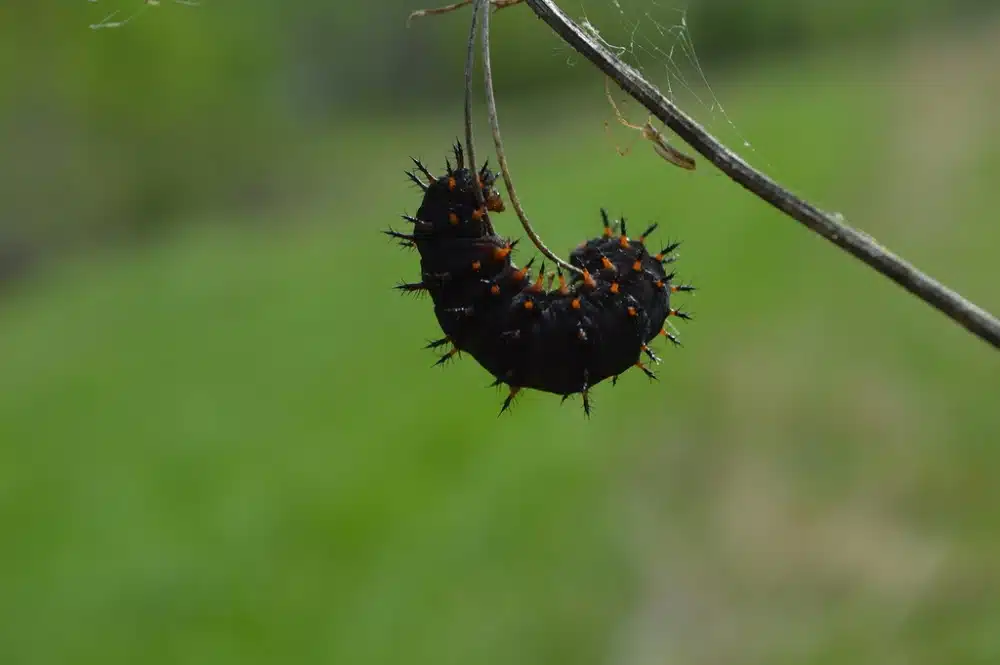
Great Spangled Fritillary caterpillars (Speyeria cybele) go through various colors across their growth stages.
They can be black, brown, or brown with a gray dorsal stripe.
Native to North America, the species is found on both coasts. It pupates into a brown, yellow and black butterfly.
You can find this type of caterpillar on various native violets.
Adult Great Spangled Fritillary butterflies feed on nectar from plants such as milkweed.
Pastures and open fields are among the places where violets and milkweed abound.
22. Cloudless Sulphur caterpillar

Cloudless Sulphur caterpillars (Phoebis sennae) are often green. They pupate into green or yellow butterflies.
Specific physical cues for easy identification include having numerous tiny blue dots across the body and yellow lines along the sides.
This caterpillar can also be yellow at certain stages of its life. However, it’s not completely yellow as black dorsal bands contrast its body.
Different types of peas are its host plants. Many of these plants have yellow flowers, which may explain the color of the species.
23. Viceroy caterpillar

Viceroy caterpillars (Limenitis archippus) are a common sight across willows. These types of trees host all types of caterpillars that turn into butterflies.
Cottonwood and other types of trees might also host the caterpillar.
Viceroy caterpillars stand out with their contrasting colors which mimic bird droppings.
A mixture of white, brown, black, and yellow colors is specific to the species.
Feeding on tree leaves, Viceroy caterpillars emerge into orange and black butterflies.
Some geographic color variations apply both to the caterpillar and the Viceroy butterfly.
24. American Snout caterpillar

Camouflaging capacities dictate the look of American Snout caterpillars (Libytheana carinenta) and butterflies.
The species starts life as a green egg that later turns into a green caterpillar.
Tiny yellow dots and lateral yellow stripes contrast the deep green color of the species.
Once an adult, this butterfly takes on the color of dead tree leaves, further camouflaging itself.
Named after its long snout, this caterpillar can be seen feeding on tree leaves from species such as hackberry.
Once an adult, the American Snout butterfly moves on to nectar from yellow flowers or to nutrition extracted directly from mud.
25. Eastern Giant Swallowtail caterpillar

Eastern Giant Swallowtail caterpillars (Papilio cresphontes) are some of the most problematic species in the world.
These caterpillars feed on citrus crops, which causes considerable economic losses. The species also feed on other plants such as sapote, but to a reduced extent.
These caterpillars later turn into some of the most common black butterflies in the world.
These are some of the largest butterflies in North America, reaching a wingspan of nearly 7 inches.
Black base color with yellow bands across the dorsal wings is characteristic of these butterflies.
26. Sleepy Orange caterpillar

A gray-to-green color is specific to the caterpillars of this genus. Certain peas such as partridge peas are among the most common hosts of the Sleepy Orange caterpillar (Abaeis nicippe).
The caterpillar feeds on both the leaves and the flowers of the plant.
Sleepy Orange caterpillars eventually turn into colorful butterflies.
Yellow, orange, and brown colors are specific to the species. Orange is the dominant color across the dorsal wings while yellow is dominant on the ventral wings.
27. Clouded Skipper caterpillar
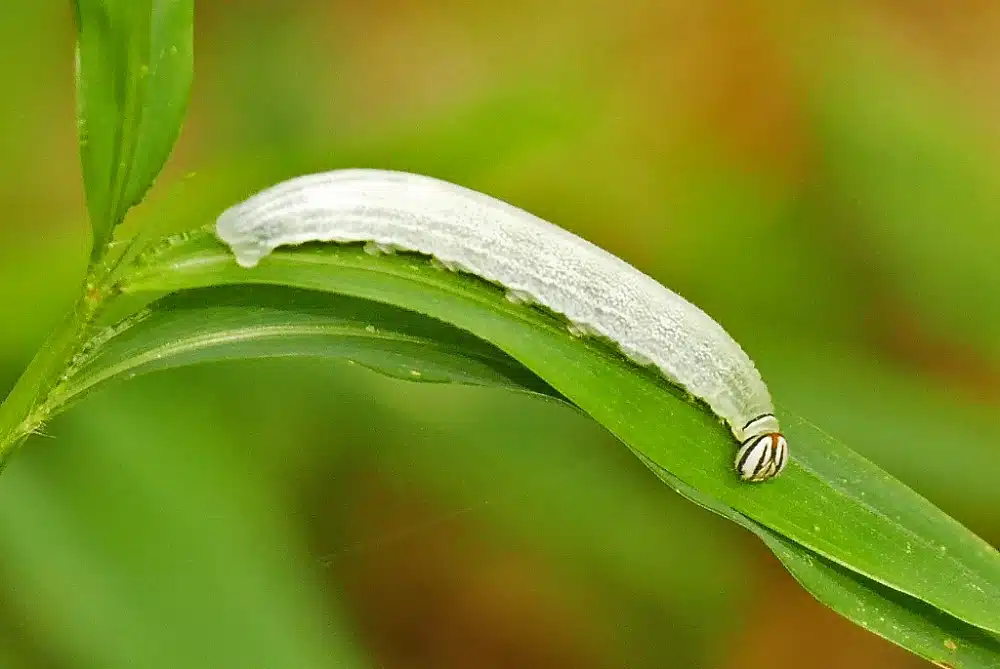
Common in the Eastern US states, this species (Lerema accius) is the caterpillar of the brown Clouded Skipper butterfly.
The caterpillar has green coloring, unlike the adult butterfly.
This base green color is uniform at first and spotted towards the later instars.
Clouded Skipper caterpillars live on various types of grass next to woodlands, in parks, or even in gardens. These include St. Augustine grass and wooly bear grasses.
Clouded Skipper butterflies move on to other plants for nectar. These include a wide range of pink flowers.
28. Western Tiger Swallowtail caterpillar

Western Tiger Swallowtail caterpillars (Papilio rutulus) change colors through their growth stages before emerging as large butterflies.
These caterpillars have a base red-orange color with a black neckband. They turn green before pupation, maintaining a black band behind the head.
This species later turns into large black and yellow butterflies. Western parts of North America are the habitat for the species.
You can find this caterpillar on different types of trees in this part of the continent. Willows and cottonwoods are among the primary host species.
29. Checkered White caterpillar

Checkered White caterpillars (Pontia protodice) have a contrasting appearance and short bodies. They measure up to 1.1 inches when grown.
The Gray base color is specific to the caterpillars. Yellow stripes contrast is base light gray appearance.
Tiny black dots are further distinguished on the gray area of its body.
These caterpillars also have short white hairs covering its body.
Checkered White caterpillars are among the few species which maintain the same base color in the pupa.
Various wild mustards are hosts to these mostly gray caterpillars.
30. Gray Buckeye caterpillar
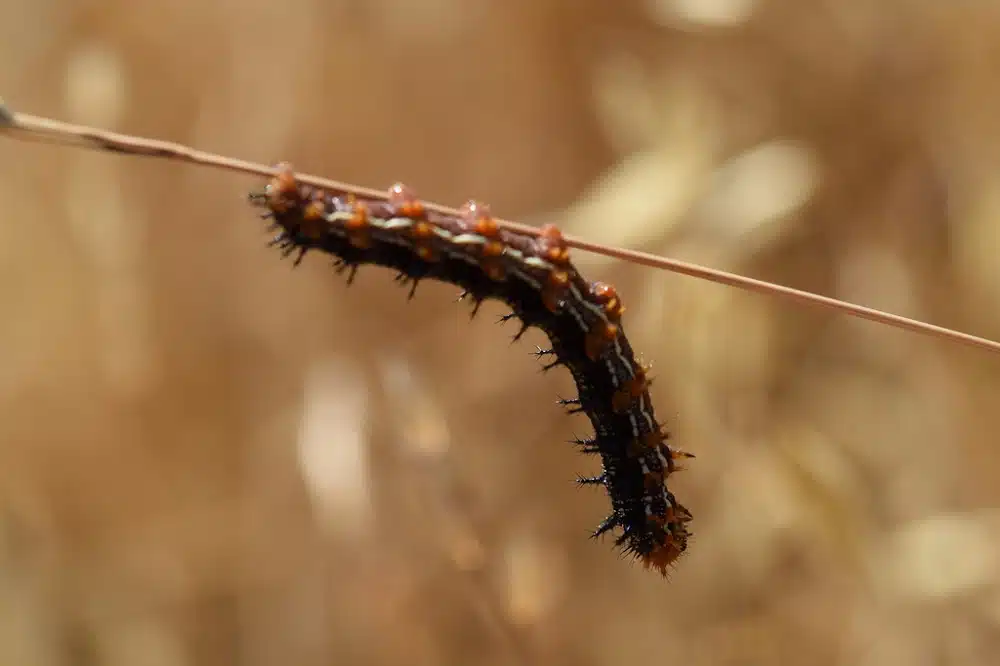
Dark brown and orange colors are seen on the Gray Buckeye caterpillar (Junonia grisea). This species has long black spikes across its body.
It was believed this caterpillar was a subspecies of the Common Buckeye but it has a new species status today.
This dual color caterpillar turns into a brown, black, and orange butterfly.
Large eyespots decorate the wings of this species, similarly to the eyespots distinguished on the Common Buckeye butterfly.
Both caterpillars and adults have defensive mechanisms. Caterpillars have spikes that look threatening while adults rely on deceiving coloring to keep predators away.
31. Eastern Comma caterpillar
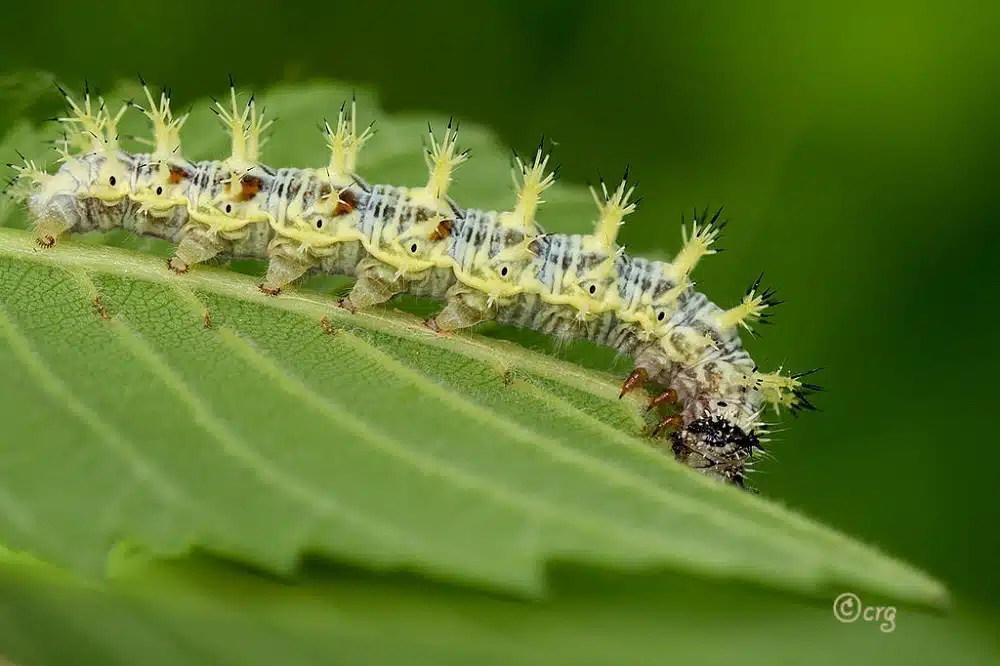
Eastern Comma caterpillars (Polygonia comma) are among the few species with white spikes instead of black or brown spikes along the body.
Black color is specific to the caterpillars of the family. As caterpillars grow they also start to show brown spots along the sides.
This species eventually turns dark brown and black into pupation.
Adults butterfly emerge with a combination of light brown and dark brown colors on the wings.
Brown colors are also seen on the underside of its wings.
Nettles are the most common hosts of the caterpillars together with the leaves of elms.
32. Tawny Emperor caterpillar
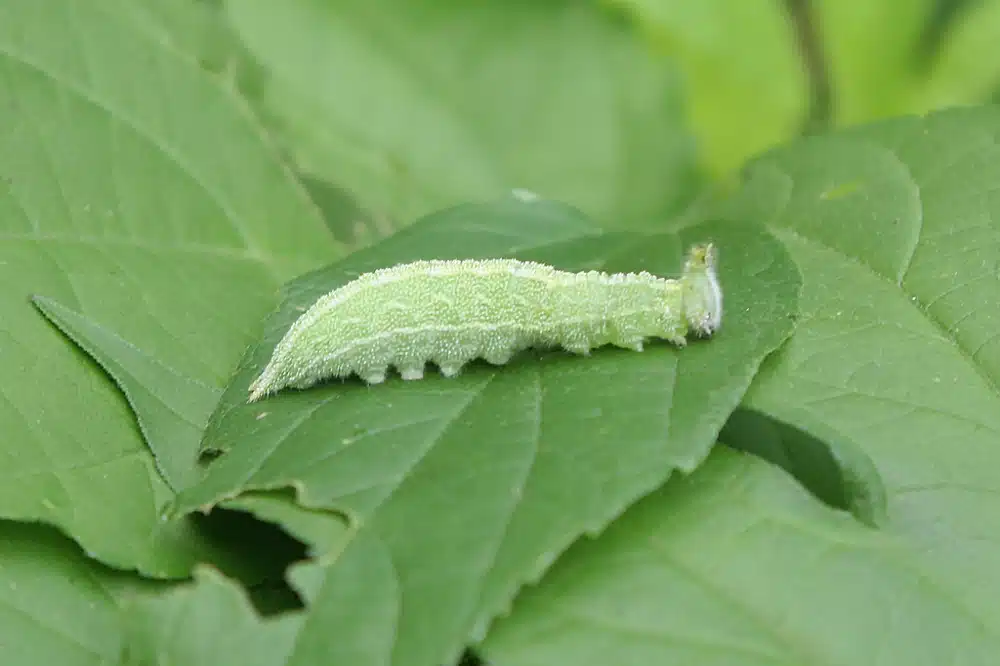
Tawny Emperor caterpillars (Asterocampa clyton) have distinct color combinations.
A light green color is specific to the caterpillars. The head of the species shows white, green, and black vertical stripes and 2 short black horns.
Yellow sides are also specific to the late instar caterpillar.
Lateral yellow coloring resembles the yellow nuances of the Tawny Emperor eggs.
Dark orange-brown colors with black patterns across the wings are specific to the Tawny Emperor.
Its ventral wings show a faded brown color that makes the emerged adult resemble a dry leaf with its closed wings.
33. Anise Swallowtail caterpillar

Native to Western parts of North America, Anise Swallowtails (Papilio zelicaon) change colors as they grow.
A base green color with black and yellow patterns across the central dorsal section is specific to this species.
It later turns into a mostly black caterpillar.
Various parsley plants are the host of the species.
The species eventually takes on the appearance of a twig that’s part of the host plant into pupation.
Caterpillars of the species maintain some of the colors of their caterpillar stage into adulthood. Anise Swallowtail butterflies are yellow and black.
34. Zebra Swallowtail caterpillar

Zebra Swallowtail caterpillars (Eurytides marcellus) emerge into zebra-colored black and white butterflies.
This species of caterpillar also changes colors as it grows. It begins life as a white and yellow species.
Alternating white and yellow bands are specific to this species.
These bands darken in time and a third alternating black line appears in later instars.
Pupation is determined into a brown chrysalis stage. Adults of the species have alternating vertical black and white stripes that inspire the name of the species.
35. Silvery Checkerspot caterpillar

Asters are the main host plant of the Silvery Checkerspot caterpillar (Chlosyne nycteis).
Red and yellow asters are among the most common hosts of the caterpillar.
You can identify this species by a mostly dual color body which is both black and brown.
Tiny white dots are further distinguishable across the dorsal side of the caterpillar. These dots are seen next to the base of its long black spikes.
Silvery Checkerspot caterpillars emerge into orange and black butterflies.
These butterflies are frequently seen feeding on purple flowers.
36. White Peacock caterpillar
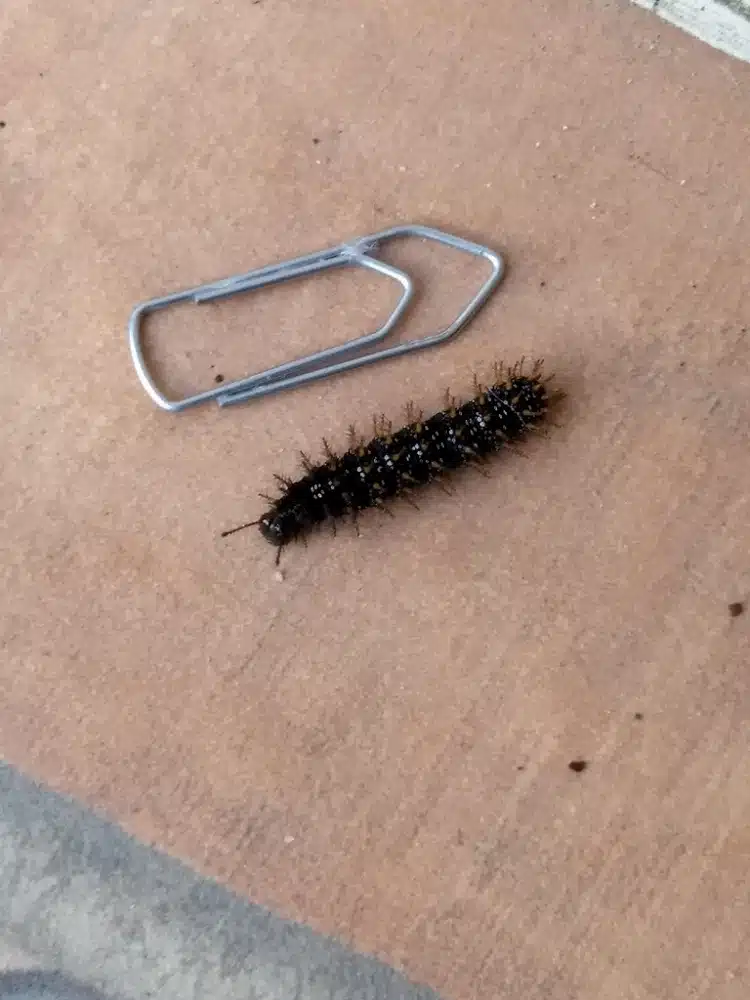
White Peacock caterpillars (Anartia jatrophae) begin life as black species with black spikes. The species slowly begin to show brown colors across the body.
The chrysalis of the White Peacock has a rare crude green color. This makes it appear as part of the host plant and improves its chances in the face of many predators.
This species eventually becomes a white, gray, and orange butterfly.
You can find White Peacock caterpillars in the Southern US states. They have a larger presence across The Caribbean.
37. Long-tailed Skipper caterpillar

These types of caterpillars (Urbanus proteus) turn into skipper butterflies with 2 long tails.
You can find caterpillars in various US regions, mainly in the Eastern and Southeastern states. The species is also native to Central America.
Various beans are among the most common hosts of the caterpillar.
This species feeds on the leaves of beans, promptly becoming a mild pest that hinders the natural growth of cultivated beans.
The caterpillar turns into a butterfly that feeds the nectar of lantana and other plants.
38. Zebra Longwing caterpillar

Small yellow eggs are laid in clumps by the female Zebra Longwing butterfly (Heliconius charithonia).
This is a species of a black and yellow butterfly.
The eggs then turn into a mostly white caterpillar that shows long black spikes and black tiny dots that contrast its body.
Zebra Longwing caterpillars further exhibit a white color with red dots and the same black spikes into the later growth stage.
Purple passionflowers are among the most common hosts of the species.
Other types of flowers such as yellow passionflowers are also among their hosts.
39. Northern Pearly-Eye caterpillar
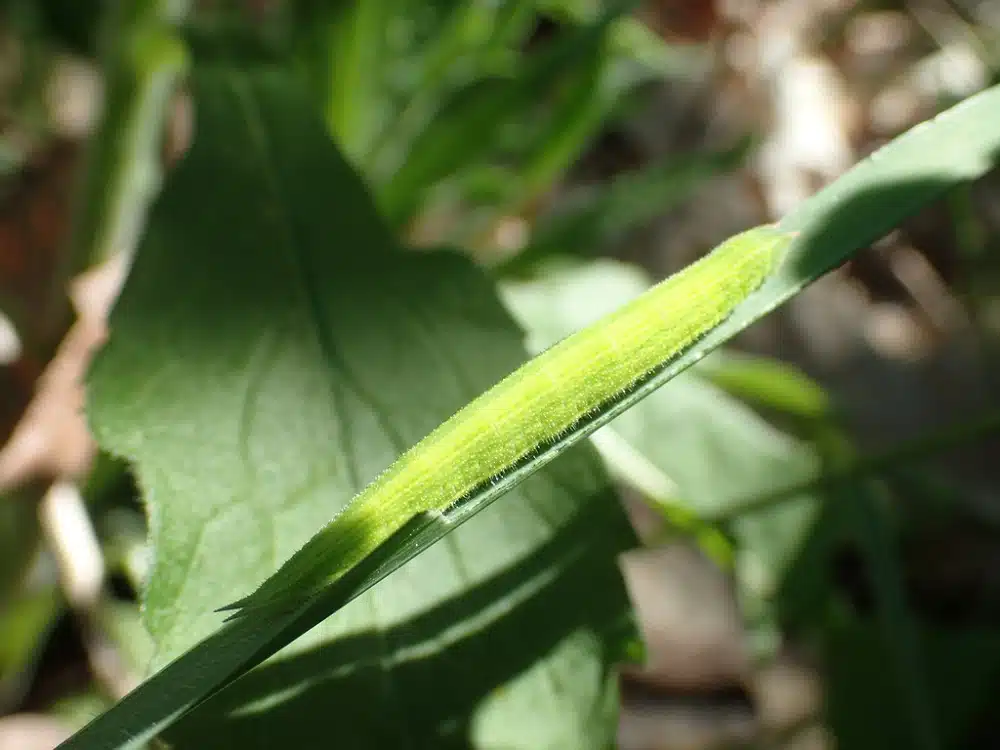
Northern Pearly-eye caterpillars (Lethe anthedon) are found in the Northern and Eastern parts of the US.
This is one of the species with contrasting color horns. The Northern Pearly-Eye caterpillar is mostly light green with short white hairs.
Dark orange horns are seen on its head.
You can find these caterpillars feeding on different types of grasses in open fields and even in gardens.
The species emerges as a brown butterfly interested in different foods such as animal dung and even carrion.
40. Lorquin’s Admiral caterpillar
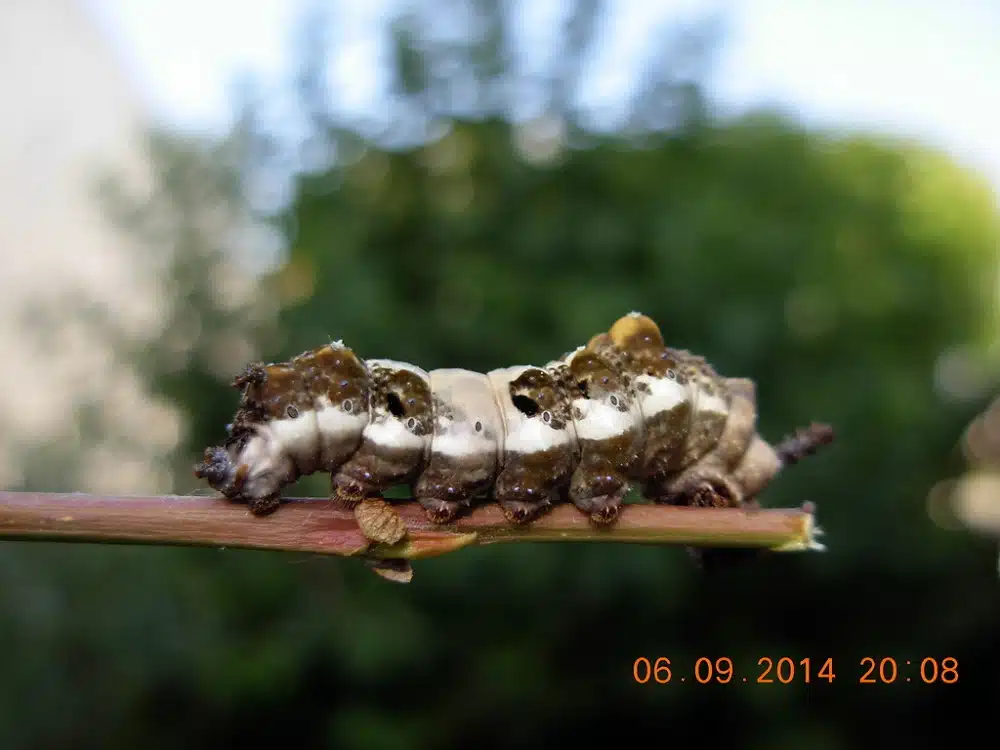
These caterpillars (Limenitis lorquini) mimic bird droppings and take on the toxins of their host trees and plants to defend themselves.
Brown, white, and black colors are specific to the caterpillar.
Wild cherries are among the most common hosts of these caterpillars. They extract toxins from the host but they are also seen on polar on occasion.
Adult butterflies of the species are also known for eating dung.
Black and brown colors are also specific to the butterfly which also shows white spots, maintaining coloring from its caterpillar stage.
You can find this species mostly in Western parts of North America.
41. Bordered Patch caterpillar

Bordered Patch caterpillars (Chlosyne lacinia) are mostly brown, turning into dark brown butterflies.
Light brown coloring is seen across the dorsal side of the species. Dark brown bands and spikes decorate its body as it grows.
You can find these caterpillars on their hosts from May onwards.
The species turns into a dark brown butterfly that’s almost black.
Tan-to-white sections are further distinguishable on the wings of the butterfly.
Ragweeds are the main hosts of the Bordered Patch caterpillar.
42. California Sister caterpillar
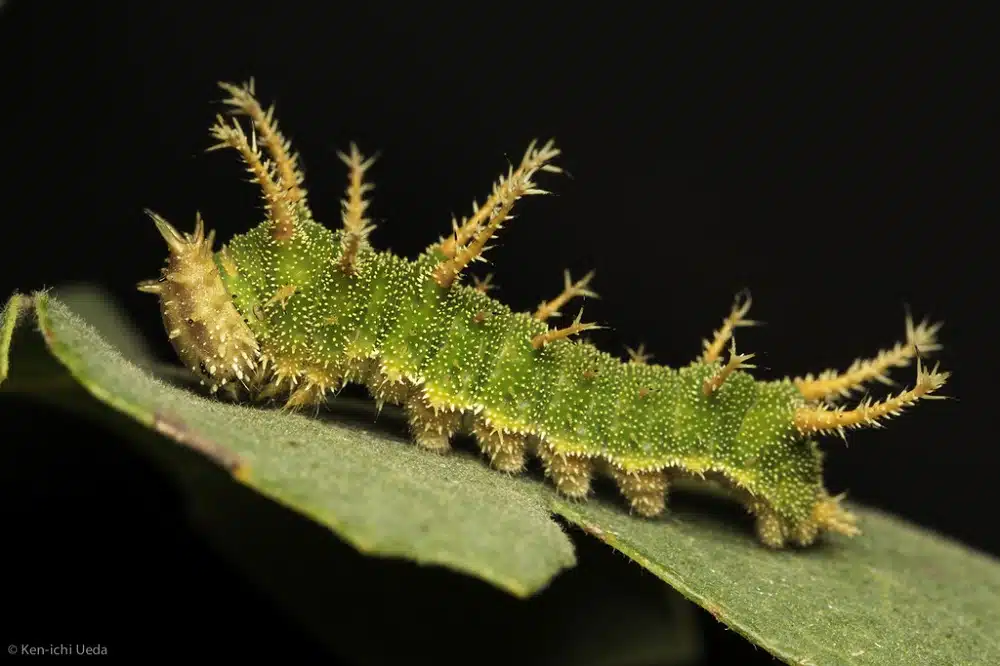
California Sister caterpillars (Adelpha californica) are native to California and the West Coast.
This species has a yellow to green color without spikes or other colors. It lives and feeds on oak leaves in the Northern parts of California.
Up to 3 broods of California Sisters are seen each year.
Emerged adults are mostly black and are known for feeding on rotting fruit. Dung is also a common food for these butterflies with a lesser appetite for nectar.
43. Western Giant Swallowtail caterpillar

This species (Papilio rumiko) begins life as a yellow-brown egg. It turns into a dark brown and yellow caterpillar.
Irregular color patterns across the body of the Western Giant Swallowtail signal a potential for dung mimicry.
Some of these colors are further distinguished on the emerging butterfly which is also brown or yellow, depending on its gender.
Male Western Giant Swallowtails are brown while females are yellow.
44. California Tortoiseshell caterpillar
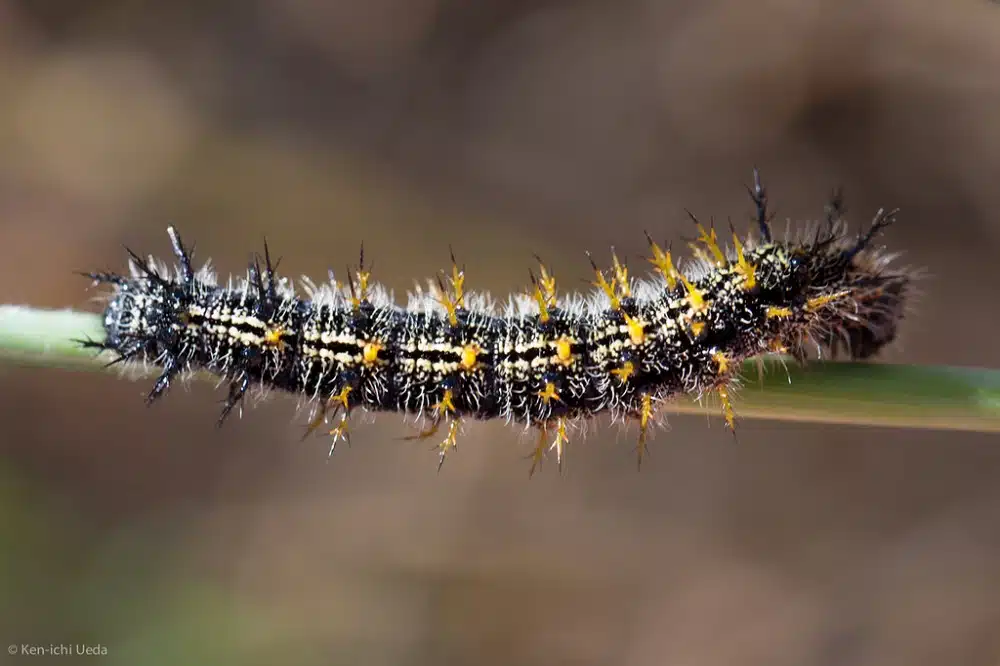
Black, brown, and yellow colors are seen on the California Tortoiseshell caterpillar (Nymphalis californica).
This species is mostly black through its growth stages. Brown spots and yellow or orange hairs develop on the caterpillar as it grows.
A common sight across Western North America including Canada, the species is only seen on lilac.
Wild lilac is preferred to lilac in gardens. This species feeds on nectar as an emerging adult.
45. Mylitta Crescent caterpillar
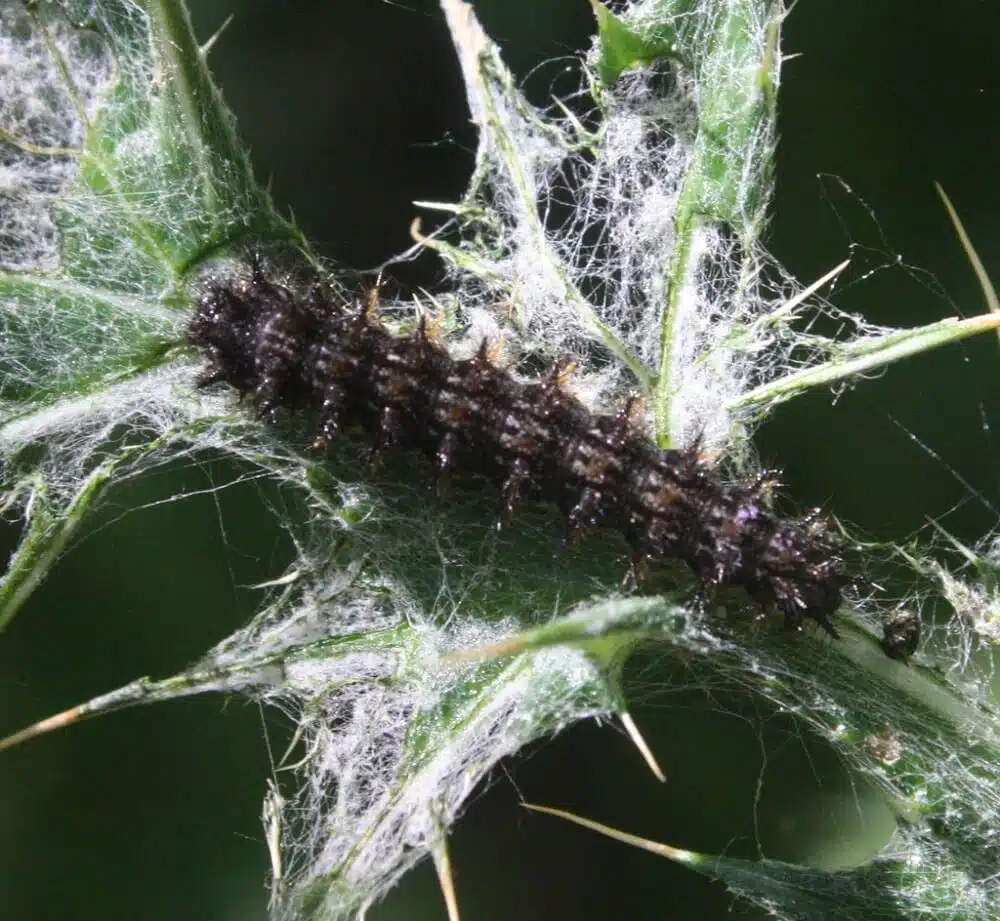
Mylitta Crescent caterpillars (Phyciodes mylitta) are native to a wider West US habitat compared to California Tortoiseshells.
This species is seen on various thistles that it feeds on. Milk thistle is the reason for its widespread distribution.
The caterpillar emerged into an orange and black butterfly which is sometimes yellow-orange and black, depending on its region.
46. Wild Indigo Duskywing caterpillar

This caterpillar (Erynnis baptisiae) has a green body with yellow lateral stripes and a black head.
Native to all Eastern US states, the species uses wild indigo as its host, as its name implies.
This is a type of plant also known as the yellow-false indigo that’s green and yellow.
Emerged adults are brown, dark brown, and black.
47. Pale Swallowtail caterpillar
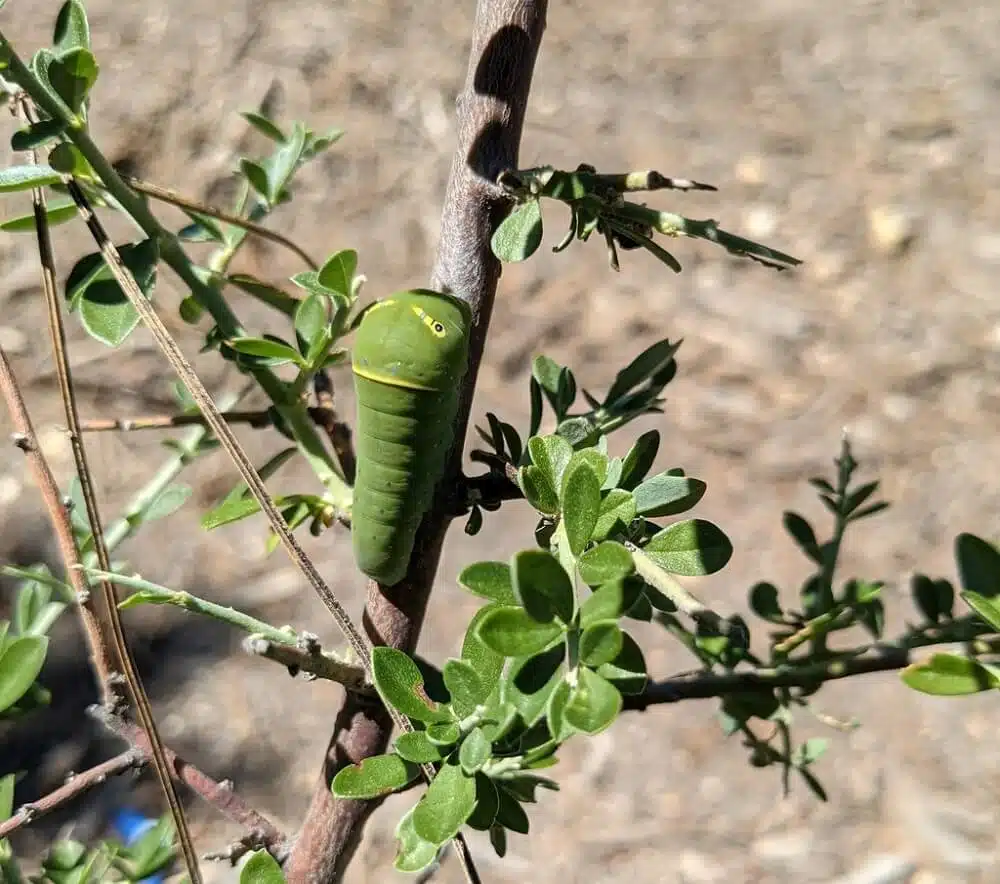
Pale Swallowtail caterpillars (Papilio eurymedon) are green. They have yellow stripes along the body while adult Pale Swallowtail butterflies are yellow and black.
These caterpillars are found both on host plants and on host trees. Most caterpillars are seen on buckbrush and wild lilacs.
Some caterpillars have adapted to feeding on black cherry.
They emerge as medium to large adults which reach a wingspan of up to 4.5 inches.
48. Two-tailed Swallowtail caterpillar
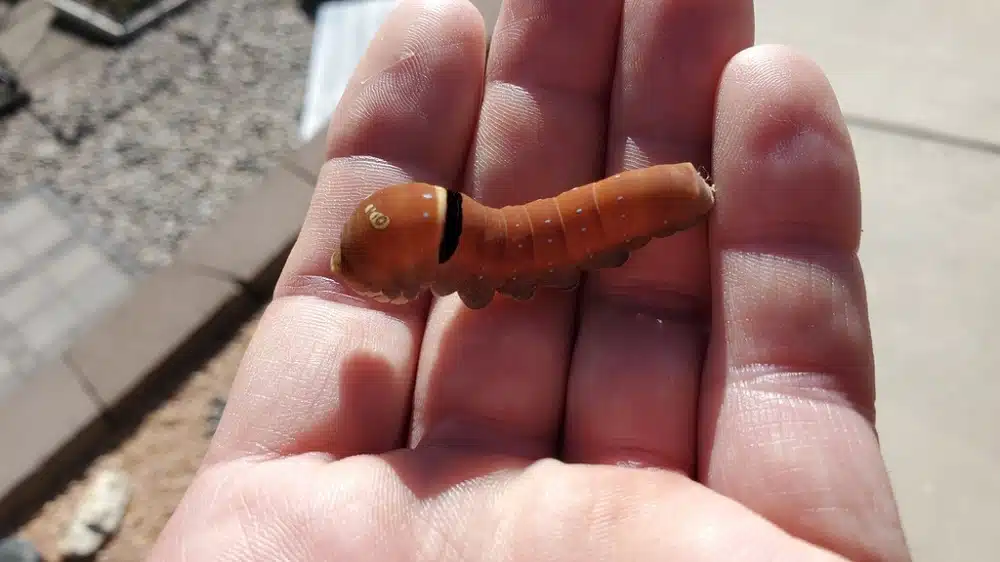
This caterpillar (Papilio multicaudata) has a mostly red color. Tiny yellow dots are seen on its head and along its body. A black band is also seen contrasting its body.
Yellow is also the main color of the Two-tailed Swallowtail. This butterfly has black secondary coloring in the form of wide margins along the wings with red-orange spots at the base of the hindwings.
These colored red-orange marks resemble the color of the Two-tailed Swallowtail caterpillar.
49. Palamedes Swallowtail caterpillar
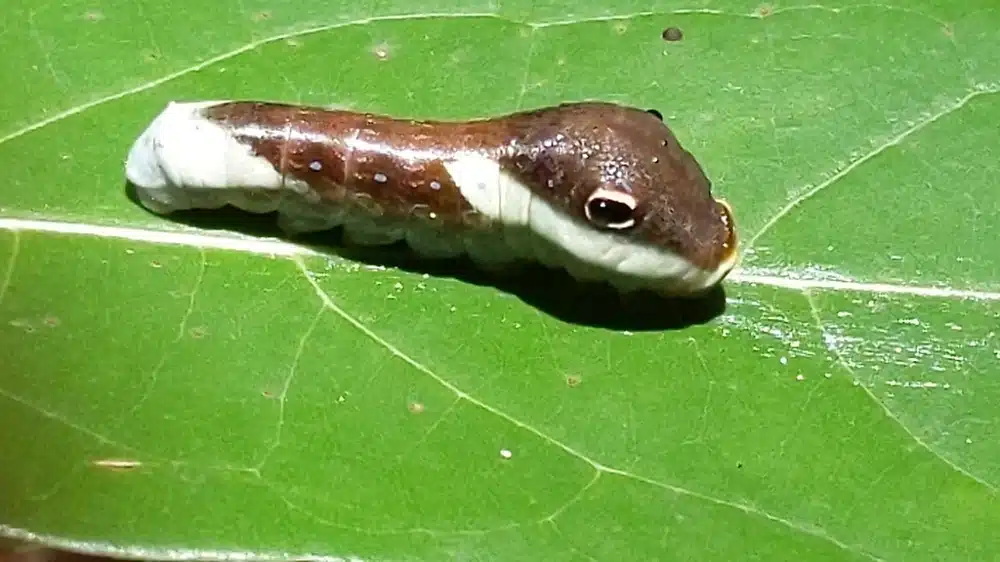
This type of caterpillar (Papilio palamedes) shows different types of mimicry from one instar to another.
Palamedes Swallowtails are mainly brown at first. They mimic bird droppings in a brown and white body color combination.
Caterpillars of this genus then turn green and brown towards the last instar. They also show large black and yellow eyespots in the last instar.
Red bay and swamp bay are their main hosts.
50. Banded Hairstreak caterpillar
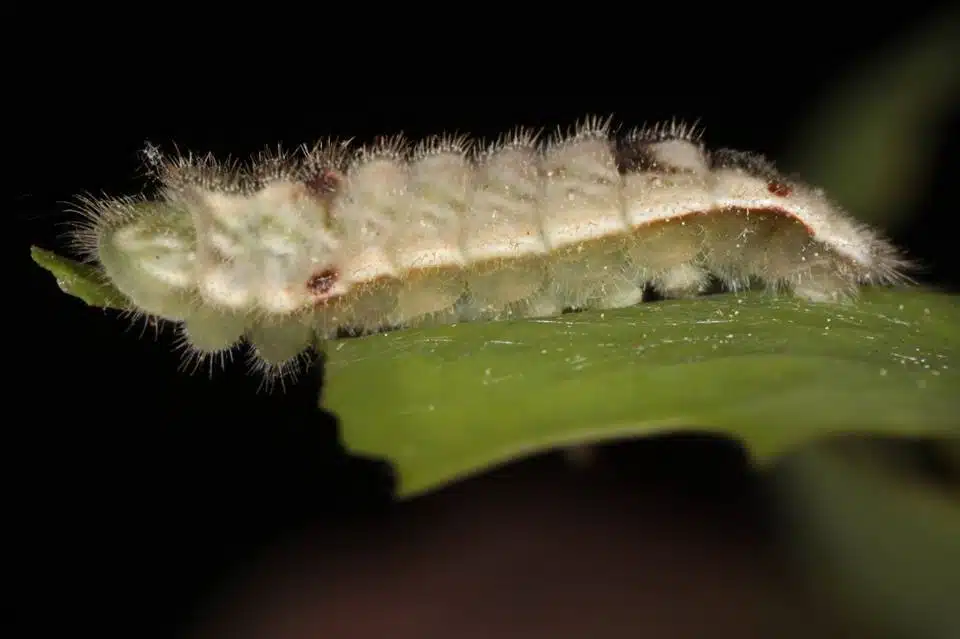
Banded Hairstreak caterpillars (Satyrium calanus) are green in the first growth stages. They turn black and green as they approach the final growth stages before emerging as adults.
Brown and gray are the main colors of the emerged butterfly.
Native to Eastern North America, this caterpillar feeds on oak leaves while the adult of the species feeds on milkweeds.
Banded Hairstreak caterpillars are seen in one brood per year.
51. Silvery Blue caterpillar
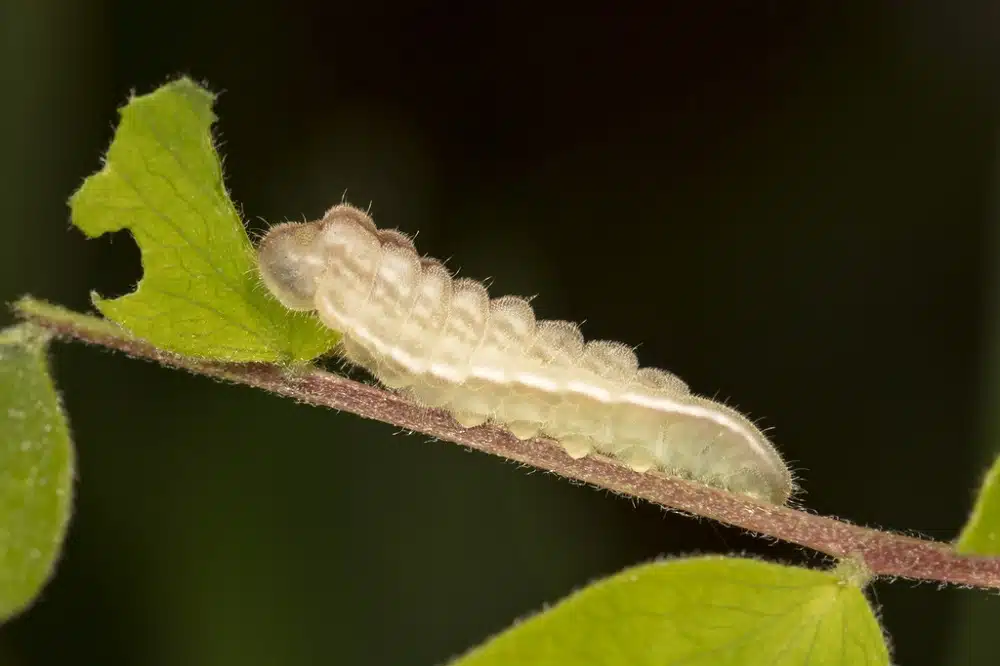
These caterpillars (Glaucopsyche lygdamus) have a green body and a brown central dorsal band with lateral margins.
It turns into a blue butterfly with gray ventral wings.
It can be seen in various valleys in direct sunlight.
Silvery Blue caterpillars grow on lupines.
52. Southern Dogface caterpillar
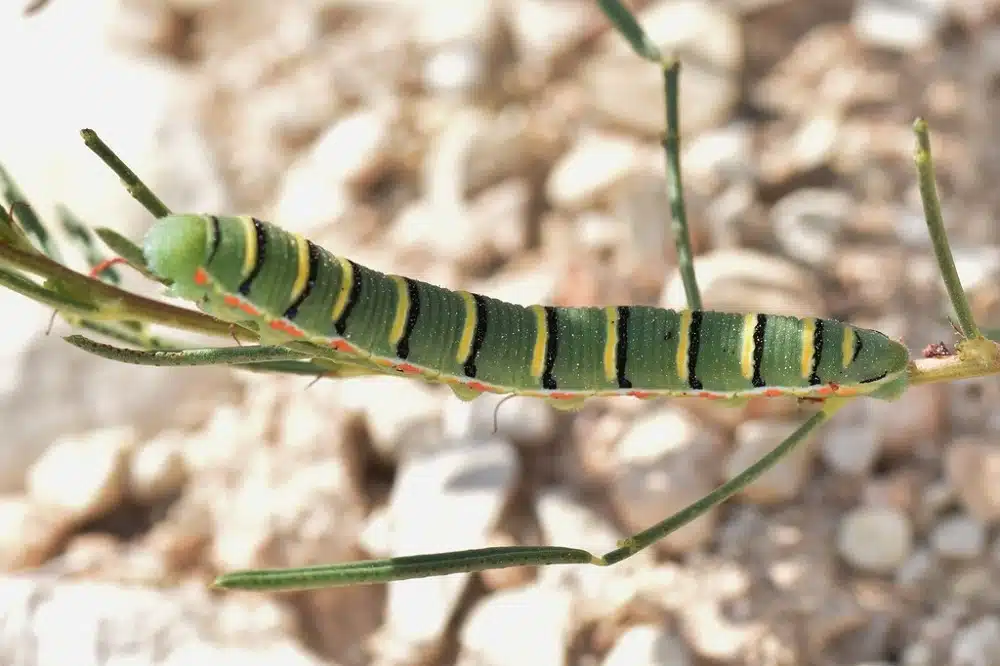
A North American native, the Southern Dogvace caterpillar (Zerene cesonia) has a base green color.
This dark green caterpillar shows black and yellow bands across its dorsal side.
You can find this species on various crops and plants. Southern Dogface caterpillars are seen on clovers and alfalfa.
Emerged adults are yellow and black on the dorsal wings. They have a yellow-lime color on the ventral wings.
Southern Dogface butterflies also feed on alfalfa and verbena nectar.
53. Goatweed Leafwing caterpillar
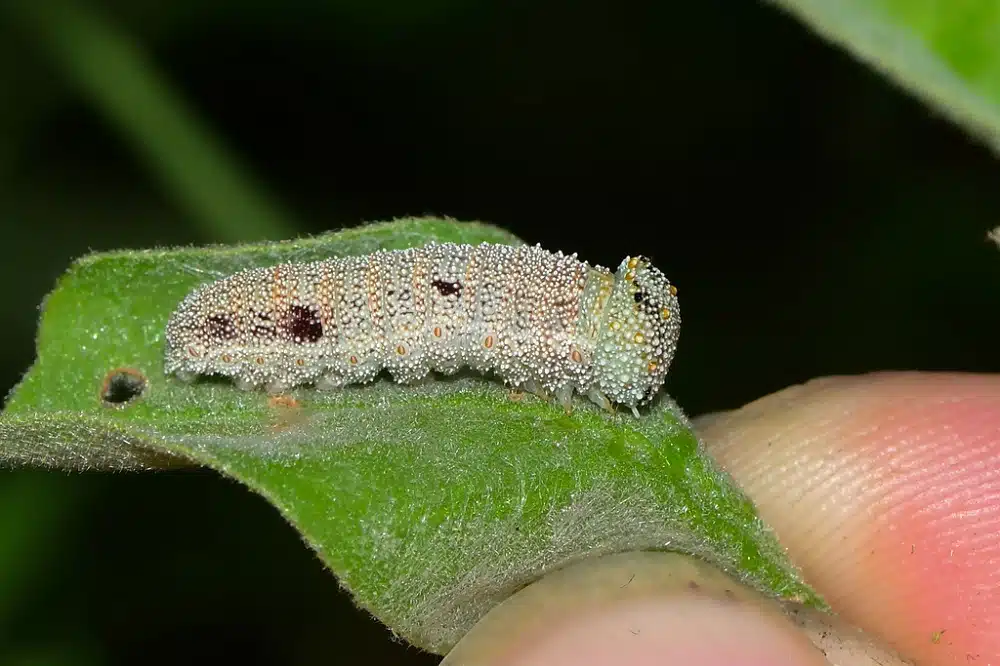
This type of caterpillar (Anaea andria) is named after its host goatweed.
It has a dark green color. The same color is seen in the pupal stage of the caterpillar.
The emerged butterfly has brown-red dorsal coloring and dark brown ventral coloring.
You can see this species feeding on rotting fruits and dung.
Goatweed Leafwing caterpillars and butterflies are only seen in the summer months. The species has widespread North American distribution except in the Western US states.
54. Canadian Tiger Swallowtail caterpillar

Canadian Tiger Swallowtail caterpillars (Papilio canadensis) are native to Canada and some parts of the Northern US.
This species of caterpillars change its coloring completely from early instars to late instars.
It begins life as a brown caterpillar mimicking bird droppings to become a green caterpillar in later growth stages.
Green color with large blue eyespots is an iconic appearance for the species that tries to look like a small snake to deter predators.
Birches and poplars are the most common host trees of the species.
Apple trees are also known hosts of the Canadian Tiger Swallowtail.
Adult Canadian Tiger Swallowtails feed on plant nectar as well as on mud which they extract nutrients from.
55. Great Southern White caterpillar
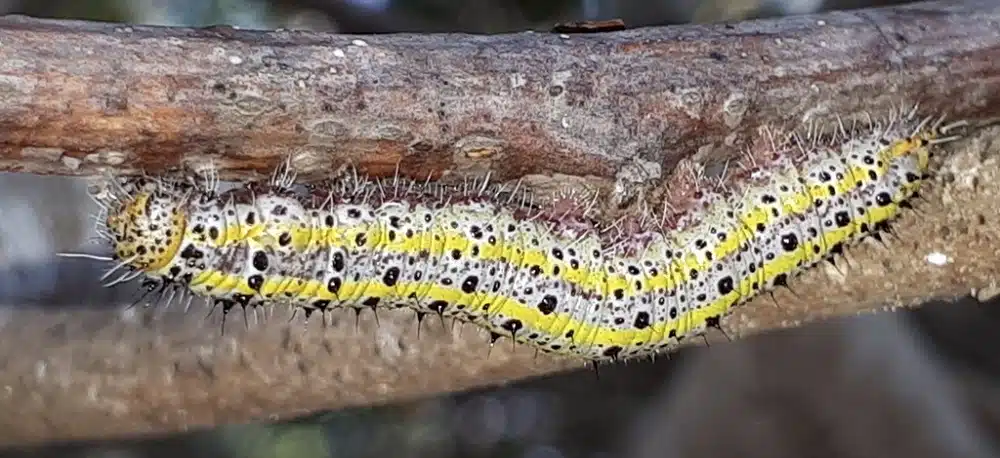
These caterpillars (Ascia monuste) are among the few that feed on both cultivated vegetables and wild plants.
Great Southern White caterpillars are seen in the garden, feeding on cabbages. They also feed on different types of mustard.
Lantana and verbena are among the most common food sources for the emerged butterfly. The adult butterfly has a pale green-white color.
You can find these caterpillars and butterflies almost throughout the year in regions such as Texas and Florida.
56. Baltimore Checkerspot caterpillar
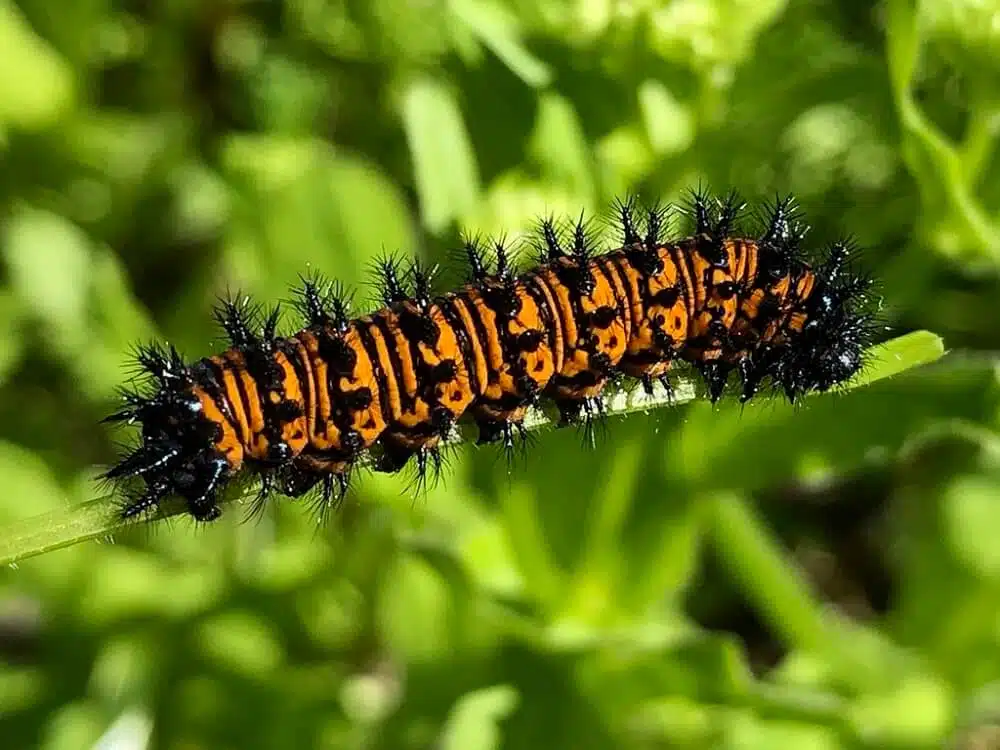
Northeastern US territories are the home of the Baltimore Checkerspot (Euphydryas phaeton). This species of caterpillar has a similar coloring too as a butterfly.
Brown and black colors dominate its appearance. Small white dots appear on this caterpillar at a later stage.
Arrowwood and plantain are the main hosts of the Baltimore Checkerspot.
The adult prefers milkweed but it can also collect nectar from different types of summer roses.
You can only see these caterpillars from June to August in Northern US territories.
The species has an expanded season further South.
57. Milbert’s Tortoiseshell caterpillar

Stinging nettle is among the hosts of Milbert’s Tortoiseshell caterpillars (Aglais milberti).
Light brown and dark brown nuances are specific to this species. The same colors are seen on the emerged butterfly which also shows orange and yellow colors.
2 broods of the species are seen per year. These broods are all tied to various species of nettle for food.
Adults are seen feeding on thistles and lilac.
You can see these caterpillars in most Western and Eastern US habitats.
It has an expansive range through Canada and up to Alaska.
The caterpillars are present in high numbers next to water sources or on marshes in valleys and fields next to woodlands.